What Is Hepatitis?

Inflammation of the liver of any cause is referred to as hepatitis. It may be caused by viruses, drugs, or alcohol, although the most common cause is viruses, termed viral hepatitis. There are several types of viral hepatitis, the most common of which being hepatitis A, B, and C. You may hear about an outbreak of hepatitis A due to contaminated food, for example.
Symptoms of Hepatitis
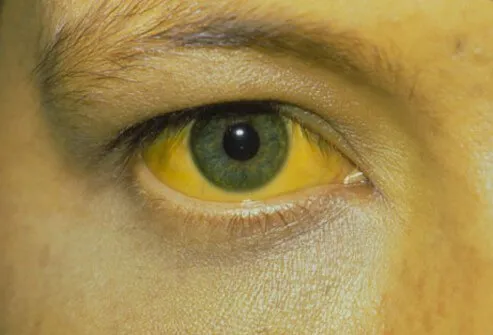
Very frequently the onset of hepatitis, the acute phase, is not associated with symptoms or signs, but when they do occur, they are usually general and include fatigue, nausea, decreased appetite, mild fever, or mild abdominal pain. Later signs more specific for liver disease may occur, specifically, yellowing of the skin and eyes (jaundice) and darkening of the urine. If the infection becomes chronic as is the case with hepatitis B and C, that is, infection lasting longer than months, the symptoms and signs of chronic liver disease may begin. At this point, the liver often is badly damaged.
What Happens with Hepatitis A?

Like many other viral diseases, Hepatitis A is highly contagious. It usually is spread from person to person via a fecal-oral route, meaning via fecal contamination of food. It usually is a mild hepatitis, and many people do not know they are infected. The virus is eliminated by the body rapidly, and it does not cause long-term damage. Good hand washing hygiene helps prevent hepatitis A.
How Does Hepatitis A Spread?

Do you know how people catch hepatitis A? Hepatitis A is spread from person to person via fecal contamination, because the virus is present in the stool. It is spread via contaminated food or water by an infected person who gets small amounts of stool on his or her hands, does not wash his or her hands, and passes the stool onto food that is eaten by others. An example of this is outbreaks of hepatitis A in daycare centers for young children when employees don't wash their hands after changing diapers, and they then pass the viruses to the next child they feed. In addition, fecal contamination of water in which shellfish live can contaminate the shellfish, and the shellfish can pass the virus to people who eat the shellfish raw.
Who Is at Risk for Hepatitis A?

Travelers to countries with high infection rates and the inhabitants of those countries are at higher risk for developing hepatitis A. The Centers for Disease Control issues travel advisories that identify the countries with outbreaks or endemic hepatitis A. Eating raw or uncooked foods increases the risk for hepatitis A.
What Happens with Hepatitis B?

A majority of adults who contract hepatitis B have between mild symptoms and no symptoms at all, and then the virus resolves spontaneously; however, about 5% of people are not able to eliminate the hepatitis B virus and develop chronic infection. If a chronically infected mother gives birth, 90% of the time her infant will be infected and develop chronic hepatitis B, usually for life. This may give rise to serious complications of liver disease later in life such as liver damage, liver failure, and liver cancer.
How Does Hepatitis B Spread?

Persons infected with hepatitis B can pass the virus to others through blood or body fluids. In the U.S., the most common way of becoming infected is through unprotected sex, although sharing an infected person's needles to inject illicit drugs also is quite common. Less common ways are by contaminated razors or toothbrushes. As previously mentioned, hepatitis B is passed from infected mother to infant in over 90% of cases.
Who Is at Risk for Hepatitis B?
Are you at risk for hepatitis B? Although unprotected sex is the most common way of becoming infected with hepatitis B, infection is more likely for people who have multiple sex partners. Shared needles also are an important means of spreading hepatitis B. Other risk factors are being a health care worker, but infection usually is related to needle sticks. There also is a risk of becoming infected by living with someone who has chronic hepatitis B, in part, due to sexual transmission or utilization of contaminated items like razors.
What Happens with Hepatitis C?
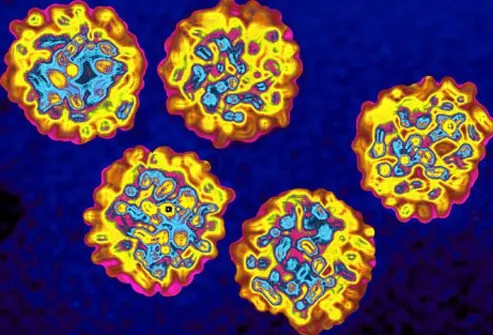
Is hepatitis C a virus? Yes. With acute hepatitis C, the virus is eliminated in 25% of people. The rest of infected people become chronically infected and later may develop serious complications such as liver failure and liver cancer. But there is now treatment for hepatitis C that usually can prevent these complications.
How Does Hepatitis C Spread?

Hepatitis C is transmitted primarily by infected blood, for example by sharing needles when injecting illicit drugs. The virus is spread much less commonly with tattoos or body piercing with a contaminated needle. Mothers pass the virus to their infants at birth, and the infant becomes chronically infected. The risk of spreading hepatitis C with unprotected sex is small, but having multiple sex partners, HIV, or rough sex increases the risk.
Who Is at Risk for Hepatitis C?

It only takes one exposure to hepatitis C to become chronically infected. Some people who have injected illegal drugs even one time or many years in the past could have chronic hepatitis C, and not know it; there are often no symptoms. People with blood transfusions prior to 1992 - when they started testing blood for transfusion for hepatitis C - also may have become chronically infected.
How Is Hepatitis Diagnosed?

Chronic hepatitis slowly attacks the liver over many years without causing symptoms. If the infection is not diagnosed and treated, many people will develop damaged livers. If suspected, viral hepatitis of all types can be diagnosed easily by blood tests.
Who Should Be Tested for Hepatitis?

It is important to test people with symptoms or exposure to hepatitis, as well as people at high risk, such as illicit drug users and people with multiple sex partners. There is a high prevalence of chronic hepatitis individuals of Asian heritage, and they also should be tested. It is estimated the 10% of Asians living in the U.S. have chronic hepatitis that probably has been present from birth.
What If You Test Positive for Hepatitis?

If testing discloses that you have viral hepatitis, there are steps to prevent your passing the viruses to family and friends. Washing your hands help prevent transmission of hepatitis A. Not sharing needles, razors, nail clippers, or toothbrushes also will reduce transmission of viral hepatitis. Everyone should be vaccinated against hepatitis B.
Hepatitis A Treatment

No treatment is needed for hepatitis A since the infection almost always resolves on its own. Nausea is common, though transient, and it is important to stay hydrated. It is recommended that strenuous exercise be avoided until the acute illness is over.
Chronic Hepatitis B Treatment

For hepatitis B, treatment is aimed at controlling the virus and preventing damage to the liver. Antiviral medications are available that will benefit most people, but the medications need to be chosen carefully, and the treatment needs to be monitored in order to assure successful treatment and to prevent or treat medication-related side effects. For some individuals, the risks of treatment may not be justified.
Chronic Hepatitis C Treatment

The treatment for chronic hepatitis C has changed for the better in recent years. Patients can expect better outcomes, shorter treatment times and fewer side effects thanks to changes in treatment.
"Direct acting" antiviral drugs have changed the way hepatitis C is treated. Treatment of chronic hepatitis C has evolved, rendering many earlier drugs obsolete. The drugs currently used include pegylated interferon, ribavirin, elbasvir, grazoprevir, ledipasvir, sofosbuvir, paritaprevir, ritonavir, ombitasvir, dasabuvir, simeprevir, and daclatasvir. These are always used in various combinations, never alone. Interferon is given by injection while the other medications are pills. Studies have shown that combinations of these drugs can cure all but a small proportion of patients; however, serious side effects of treatment can occur.
Treatment options need to be discussed with a knowledgeable physician, as the appropriate combination is dependent upon multiple factors. These include genotype (there are 6), prior treatment and results, drug intolerances, presence of compensated liver disease or uncompensated cirrhosis, presence of HIV co-infection, other complicating conditions and liver transplantation.
Monitoring Chronic Hepatitis
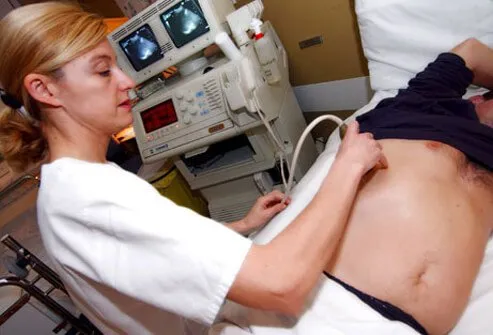
Monitoring the progression of liver disease and its treatment are the cornerstones of managing hepatitis B and C. Doctors regularly follow blood tests to determine how well your liver is functioning. Ultrasound examinations and CT scans can determine if there are complications such as cirrhosis or liver cancer that can be treated more effectively if found early. Some people will not need treatment.
Liver function tests and imaging can also help identify problems like hepatic steatosis (hepatic lipidosis), hepatic encephalopathy (hepatic coma), hepatic cysts, hepatic adenoma, hepatic hemangioma, diffuse hepatic steatosis, hepatic lesions, hepatic fibrosis, and fulminant hepatic failure.
Imaging helps doctors see the hepatic portal vein, hepatic portal system, hepatic vein, hepatic artery (common hepatic artery), hepatic duct (common hepatic duct), and hepatic lobes.
Complications: Cirrhosis
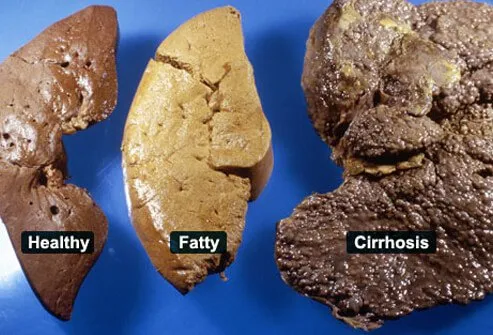
Cirrhosis is the most common complication of chronic hepatitis. Cirrhosis can be detected with simple tests, but the liver biopsy is the best way to diagnose it. Cirrhosis occurs as the liver is destroyed and it is associated with liver failure, a life-threatening condition. The signs of cirrhosis include retention of fluid (swelling of the abdomen or lower extremities), fatigue, nausea, and weight loss. Later, confusion and jaundice occur due to the accumulation of chemicals normally removed by a healthy liver.
Complications: Liver Cancer
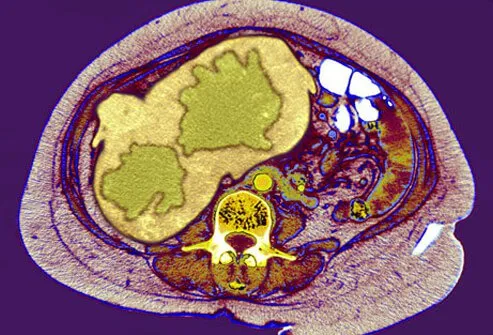
The major cause of liver cancer is hepatitis B and C, and can develop silently as the liver becomes cirrhotic. Blood tests, ultrasound examinations, CT and MRI scans can identify the cancers (seen here in green). Biopsy of the liver is needed to definitely make a diagnosis of cancer. If the cancers are found early, a small proportion of patients can be cured.
Liver Transplant

The liver serves many functions including the manufacture and removal of chemicals that allow cells to function normally, digestion of food, elimination of toxic chemicals, and the production of many proteins that the body needs. Thus, if a large portion of the liver is damaged, the liver cannot perform these critical functions; it is impossible to live without a liver. If the liver fails, a liver transplant may be the only hope, but it is not easy to find a healthy liver to transplant.
Hepatitis A and B Vaccines

Vaccines can protect against hepatitis A and B. The Centers for Disease Control recommends hepatitis A vaccination for children 12 to 23 months of age and for adults who travel or work in locations with a higher prevalence of hepatitis A infection. Vaccination for hepatitis A also should be given to people with hepatitis B and C. If the mother has chronic hepatitis B, the infant should receive the hepatitis B vaccine as well as hepatitis B immune globulin to prevent the development of chronic hepatitis B. There is no vaccine for hepatitis C (there are at least 7 genotypes and about 60 subtypes; a vaccine would need to be effective against most of them).
Protecting Your Liver

If you have chronic hepatitis, you should prevent further damage to your liver, for example, by not drinking alcohol. Since some medications and supplements can damage the liver, before taking them you should discuss them with your doctor. Regular appointments for follow-up are important. Early progression of the disease or complications are likely to change treatment.
Hepatitis C, Hep B, Hep A: Symptoms, Causes, Treatment
This tool does not provide medical advice. See additional information: 
© 1996-2024 WebMD, LLC. All rights reserved.
